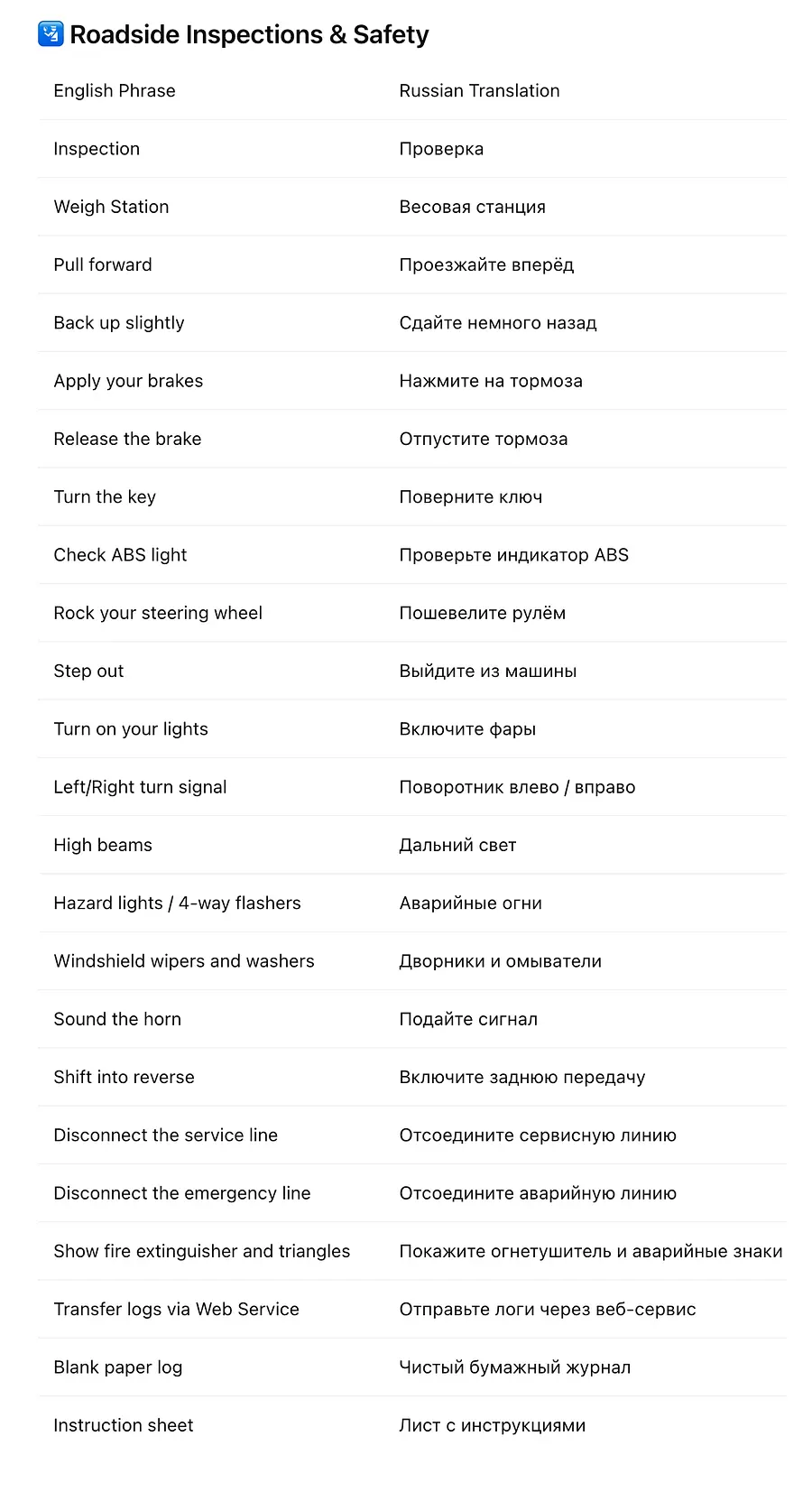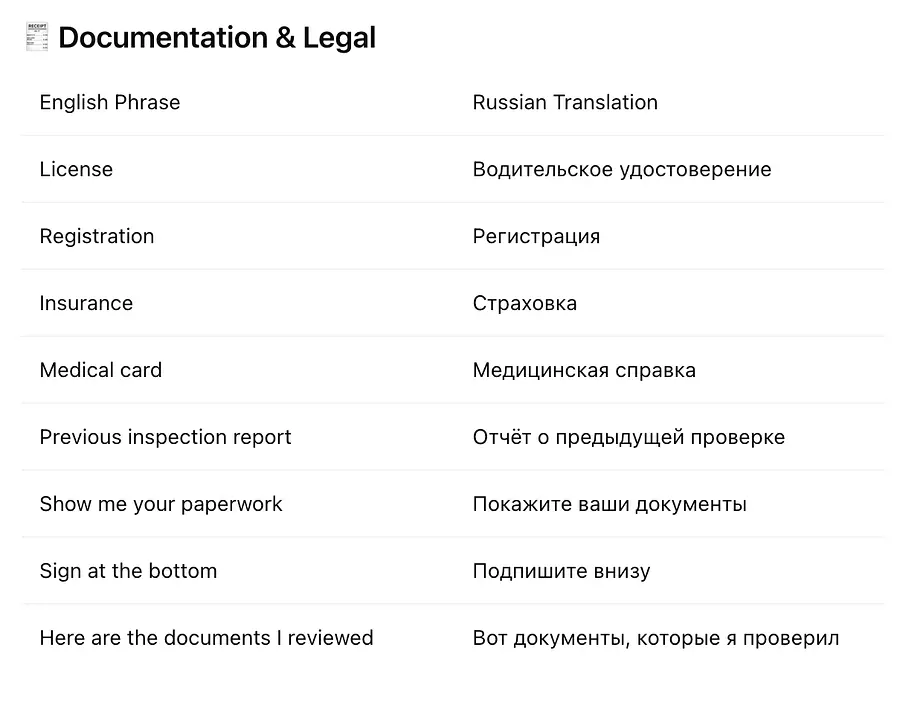
GENERAL • May 20, 2025
Everyday English on the Road
5 minutes read
https://blog.driverseo.com/everyday-english-on-the-road-9c4a1151
Copied
The road teaches everyone—regardless of language. But sometimes, what gets lost isn’t your way on the map; it’s your way in the conversation.
This guide is for drivers whose first language isn't English—people who want to feel a little more confident, a little more connected, and a lot less confused when they pull into a fuel stop, speak with a shipper, or talk to an officer. Not perfect English. Just road-ready English.
Drivers may encounter inspections through various scenarios:
Drivers may encounter inspections through various scenarios:
-
Roadside Inspections: Often unplanned, these can be triggered by factors such as driver behavior or observable vehicle defects. For instance, a cracked windshield, malfunctioning lights, or worn tires can prompt an officer to initiate an inspection.
-
Weigh Station Checks: Routine stops where officers pull drivers in for random inspections, paperwork review, or to verify logs and credentials.
- Post-Accident Inspections: These focus on identifying factors that may have contributed to a crash but often uncover unrelated violations as well.
Regardless of the type of stop, one factor remains crucial: communication.
Recently, there has been a renewed focus on enforcing English proficiency among commercial drivers. For instance, in April 2025, Arkansas enacted Act 604, which mandates that commercial drivers demonstrate the ability to converse with the public, understand highway signs, respond to official inquiries, and complete reports in English. Failure to do so can result in fines of $500 for the first offense and $1,000 for subsequent offenses . This law reinstates stricter language requirements that had been relaxed in 2016 when the Federal Motor Carrier Safety Administration (FMCSA) allowed the use of interpretation services during roadside inspections.
The result? Even minor issues can escalate—not because of intent, but due to communication gaps. This guide aims to help close that gap.
🔄 Officer Phrases and Suggested Responses
🟦 Greetings & Opening Questions
Officer: “Good morning.”
Driver: “Good morning.”
Driver: “Good morning.”
Officer: “How are you today?”
Driver: “I’m good, thank you. How are you?”
Driver: “I’m good, thank you. How are you?”
🟦 Driving Instructions
Officer: “Pull forward.”
Driver: “Yes, sir/ma’am.” (Begin moving slowly forward)
Driver: “Yes, sir/ma’am.” (Begin moving slowly forward)
Officer: “Back up slightly.”
Driver: “Okay.” (Reverse gently)
Driver: “Okay.” (Reverse gently)
Officer: “Stay on the outside lane.”
Driver: “Yes, outside lane.” (Repeat to confirm understanding)
Driver: “Yes, outside lane.” (Repeat to confirm understanding)
Officer: “Follow signs: ‘Inspect – Keep Left’ or ‘Park – Keep Right.’”
Driver: “Yes, I’ll follow the sign.”
Driver: “Yes, I’ll follow the sign.”
🟦 Vehicle Operation
Officer: “Turn the key.”
Driver: (Turn ignition or acknowledge with a nod)
Driver: (Turn ignition or acknowledge with a nod)
Officer: “Check ABS light.”
Driver: “Yes, I see it.” / “It turned off.”
Driver: “Yes, I see it.” / “It turned off.”
Officer: “Apply your brakes.”
Driver: (Apply brakes) “Brakes on.”
Driver: (Apply brakes) “Brakes on.”
Officer: “Release the brake.”
Driver: (Release brakes) “Brakes off.”
Driver: (Release brakes) “Brakes off.”
Officer: “Turn on your lights.”
Driver: (Turns on all lights) “Lights on.”
Driver: (Turns on all lights) “Lights on.”
Officer: “Left turn signal.”
Driver: (Activates) “Left signal.”
Driver: (Activates) “Left signal.”
Officer: “Right turn signal.”
Driver: (Activates) “Right signal.”
Driver: (Activates) “Right signal.”
Officer: “High beams.”
Driver: (Activates) “High beams on.”
Driver: (Activates) “High beams on.”
Officer: “4-way flashers.”
Driver: (Activates) “Hazard lights on.”
Driver: (Activates) “Hazard lights on.”
Officer: “Windshield wipers and washers.”
Driver: (Activates) “Wipers and spray.”
Driver: (Activates) “Wipers and spray.”
Officer: “Sound the horn.”
Driver: (Honks horn) “Horn works.”
Driver: (Honks horn) “Horn works.”
Officer: “Shift into reverse.”
Driver: (Shifts) “In reverse.”
Driver: (Shifts) “In reverse.”
Officer: “Rock your steering.”
Driver: (Moves wheel gently side-to-side) “Steering okay.”
Driver: (Moves wheel gently side-to-side) “Steering okay.”
🟦 Document & Log Requests
Officer: “Transfer your ELD logs via Web Service.”
Driver: “Yes. I will send now.” (Perform transfer)
Driver: “Yes. I will send now.” (Perform transfer)
Officer: “Do you have blank logs and your instruction sheet?”
Driver: “Yes, here they are.”
Driver: “Yes, here they are.”
Officer: “Show me your license, registration, insurance, and medical card.”
Driver: “Yes, one moment please.” (Hands over documents)
Driver: “Yes, one moment please.” (Hands over documents)
Officer: “Give me your last inspection report.”
Driver: “Here it is.”
Driver: “Here it is.”
🟦 Safety Equipment
Officer: “Show me your triangles and fire extinguisher.”
Driver: “Yes, one moment.” (Retrieves equipment)
Driver: “Yes, one moment.” (Retrieves equipment)
🟦 Vehicle Check Questions
Officer: “Is anyone else in the vehicle?”
Driver: “No, just me.” / “Yes, one person with me.”
Driver: “No, just me.” / “Yes, one person with me.”
Officer: “Engine on or off?”
Driver: “On.” / “Off.” (State status clearly)
Driver: “On.” / “Off.” (State status clearly)
Officer: “Disconnect the service line.”
Driver: (Performs task) “Service line disconnected.”
Driver: (Performs task) “Service line disconnected.”
Officer: “Disconnect the emergency line.”
Driver: (Performs task) “Emergency line disconnected.”
Driver: (Performs task) “Emergency line disconnected.”
🟦 Final Instructions
Officer: “Step out.”
Driver: “Okay.” (Exits safely)
Driver: “Okay.” (Exits safely)
Officer: “Here are the documents I reviewed.”
Driver: “Thank you.”
Driver: “Thank you.”
Officer: “Sign at the bottom.”
Driver: (Reads, then signs) “Signed.”
🇺🇸 Cultural Expectations (U.S. Roadside Encounters)
These are not rules—but patterns that officers, shippers, and others may expect during interaction.
✅ What’s Expected:
- Be direct, but respectful. You don’t need to be overly friendly. Clear and polite is enough.
- Use short, complete answers. Example: “Yes, I have my paperwork.” vs. just “Yes.”
- Keep your hands visible. Especially when asked to exit the vehicle or hand something over.
- Listen first, then act. Don’t rush to perform the task before the officer finishes speaking.
-
If you don’t understand, ask clearly. Example: “English is my second language—can you repeat that slowly, please?”
🚫 What Might Be Misinterpreted:
-
Not answering or responding with silence can be seen as uncooperative.
- Fast or defensive body language (arms crossed, pacing, loud tone) may be viewed as resistant or aggressive.
- Oversharing—like explaining too much unasked—can create confusion or suspicion.
Companion Glossary: Road-Ready English (English–Bulgarian)
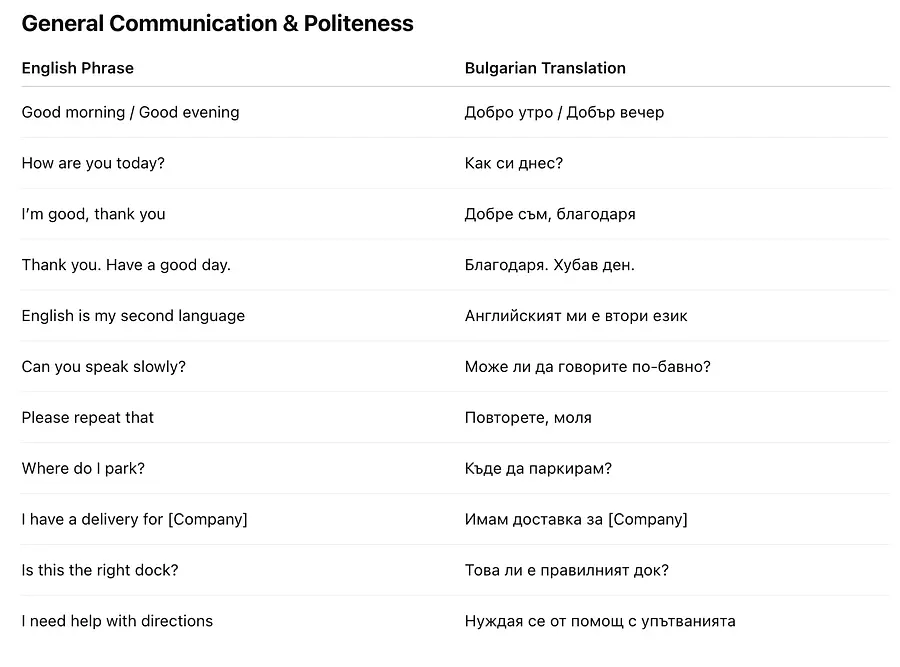
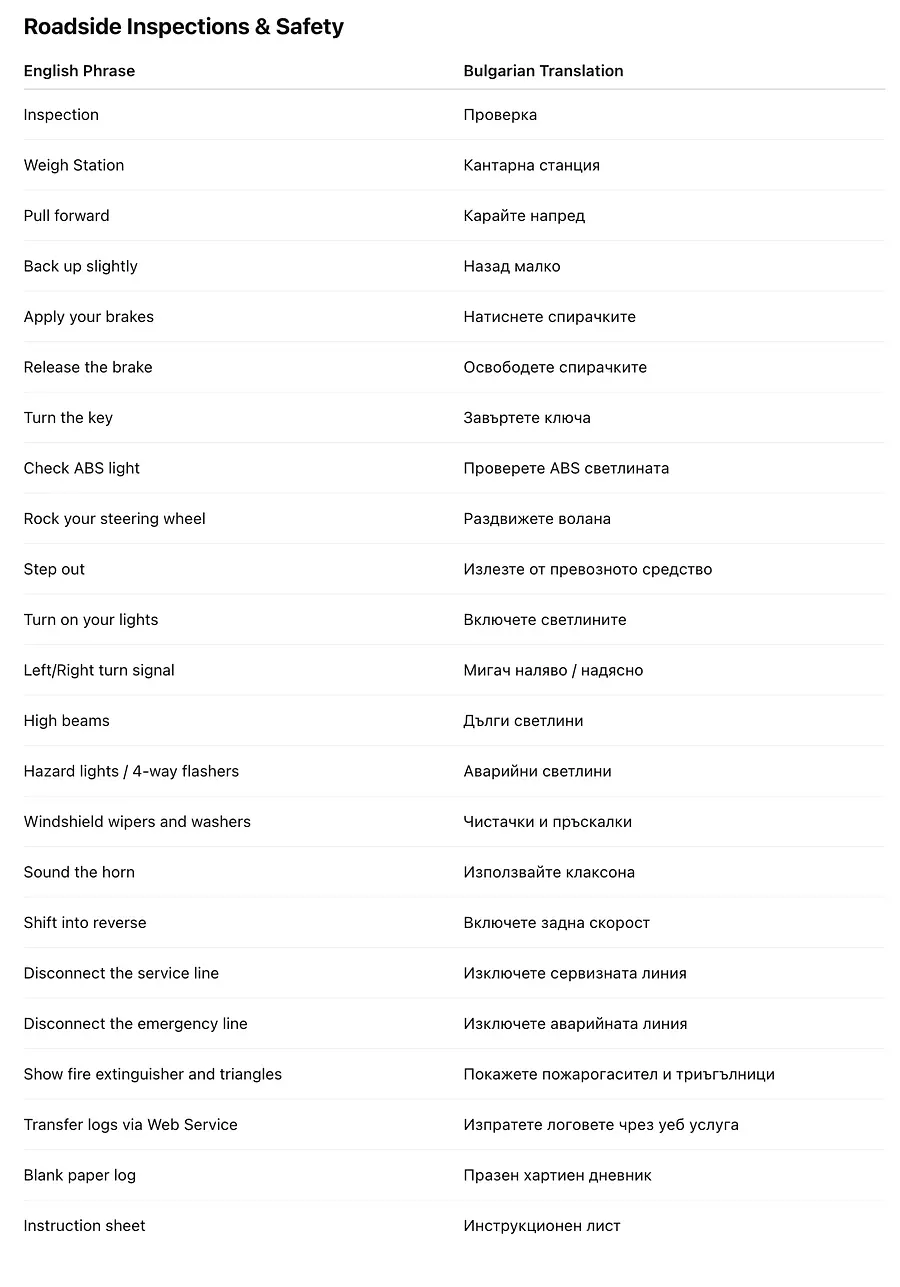

Companion Glossary: Road-Ready English (English–Tajik)

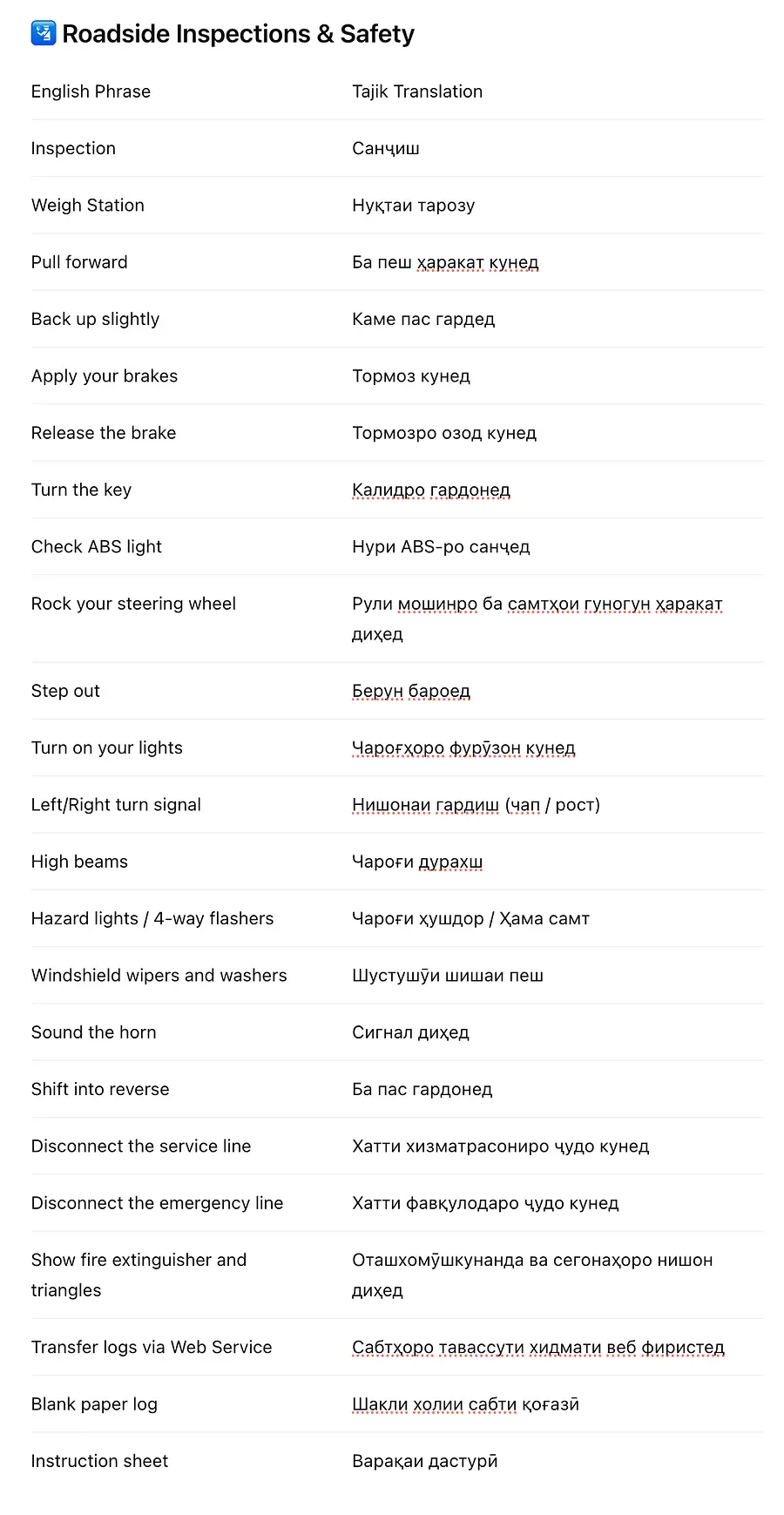

Companion Glossary: Road-Ready English (English–Spanish)



Companion Glossary: Road-Ready English (English–Russian)

